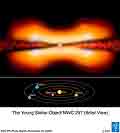Science with the VLTI
Introduction
With the instruments PIONIER and GRAVITY in the near-infrared and MATISSE in the mid-infrared, valuable data can be produced for a broad range of research areas such as:
- The structure and composition of the outer solar system.
- The mass function of low mass stars, brown dwarfs (BD) and planets.
- The detection of extra-solar planets.
- The formation mechanism of stars and planetary systems.
- The surface structure of stars.
- The accurate distance to galactic Cepheids, the Large Magellanic Cloud and globular clusters.
- The physical mechanisms responsible for stellar pulsation, mass loss and dust formation in stellar envelopes and evolution to the Planetary Nebula and White Dwarf stages.
- The structure and evolution of stellar and galactic nuclear accretion disks and associated features (jets, dust torii, NarrowLine Regions, Broad Line Regions etc).
- The nature of the Milky Way nucleus surrounding the central black hole (BH).
- Interacting binary evolution and mass transfer mechanisms.
- The structure of the circum-stellar environment of stellar BH and neutron stars.
- The evolution of the expanding shells of novae and supernovae and their interaction with the interstellar
medium and its chemical enrichment.
A few examples of exciting research topics for the VLTI
 Young Stellar Objects (YSOs)
Young Stellar Objects (YSOs)
The study of circumstellar disks around young stellar objects is an exciting area of astrophysics on which the technique of infrared interferometry has a big impact. Observations of objects in the T Tauri, Herbig Ae/Be, FU Ori and high mass young star categories are contributing to a better understanding of this period in the evolution of proto-planetary systems.
The majority of the young stars are observed to have a disk-like distribution of matter. This is a stage in which the star is formed but is still accreting matter. Young Stellar Objects (YSOs) play an important role for the understanding of star and planet formation, since the disks are believed to be the location where planets are born. The distribution of material surrounding young stars is not yet completely understood. Several different models have been developed to explain the spectral energy distribution (SED). But data from the near-IR and mid-IR spectral region is helping to constrain more and more the geometry and nature of the circumstellar material
YSOs offer a rich circumstellar environment such as accretion disks, stellar companions, optical jets, stellar winds and show a variety of different phenomena like infrared excesses, luminosity variations and highly collimated jets. Most of these phenomena occur in a region with a size less than 1 AU. Long-baseline optical interferometry, with its milliarcsecond (mas) resolution typically corresponding to 0.1 AU at 100 pc is particularly suitable to probe the physical processes and interactions of the early stages of star and planet formation.The VLTI with the instruments MIDI in the mid-infrared and AMBER in the Near-Infrared is well suited for the size scales and material temperatures in circumstellar disks. Near-infrared wavelengths (H and K, 1.6 and 2.2 microns) are primarily sensitive to material emitting near 1000 K, which corresponds to material in the inner disk, while mid-infrared observations (N band, 10 microns) are most sensitive to material at hundreds of Kelvin, corresponding to the middle disk and the habitable zone.
Infrared interferometry has already led to significant progress in the field of star and planet formation. But the new knowledge also raises new questions. But observational prospects are improving. Higher spectral resolution will allow observations of the gas and provide new probes of jets, winds, and accretion onto the central star. Closure phase and imaging will help eliminate model uncertainties and dependencies. The VLTI therefore represents a unique opportunity for scientific research in the field of young stellar objects.
 Extra-solar Planets
Extra-solar Planets
The search for extra-solar planets and their more precise description and characterisation constitute an area of major interest not only for scientists but also for a broader public. In the border zone between real stars, brown dwarfs and planets the VLTI has the ability to substancially enlarge the sample of stars searched for planets.
The VLTI PRIMA facility will be able to perform high precision astrometry and direct imaging with high spectral resolution of the planets and the gaseous and dust disks out of which they are most likely to form. These techniques combined to the radial velocity method will considerably improve the precision of the planets mass determination.
 Active galactic nuclei (AGN)
Active galactic nuclei (AGN)
Active galactic nuclei (AGN) are one of the most energetic and mysterious phenomena in the universe. In some galaxies indeed, the core generates huge amounts of energy which are orders of magnitudes higher than for normal galaxies, such as the Milky Way. AGNs are thought to be powered by accretion onto a massive black hole.
The VLTI is very well suited to study objects far away from our galaxy.With its high sensitivity to thermal radiation, MIDI is ideally adapted to study heated cosmic material around a radiating nucleus. The ultraviolet and optical radiation from the hot material surrounding the black hole indeed heats the dust torus to several hundred degrees. The absorbed energy is then re-radiated in the thermal infrared between 5 and 100 microns.
The MIDI instrument on the VLTI is thus a quite appropriate instrument to peer at the enigmatic dust and gas tori believed to be located around giant black holes at the centres of quasars and Active Galactic Nuclei.
 AGB, Post-AGB stars and PNe
AGB, Post-AGB stars and PNe
At the late stage of stellar evolution, stars return most of their mass to the interstellar space before they end their life in supernova explosions for massive stars (M ≥ 8Msolar ) or as planetary nebulae (PNe) in the case of low- and intermediate-mass stars. While mass loss plays an important role not only in stellar evolution but also in the chemical evolution of the Galaxy, the mass loss mechanism of evolved stars is still not completely understood. In the circumstellar environment of cool evolved stars such as asymptotic giant branch (AGB) stars or red supergiants (RSGs), complicated physical and chemical processes take place, being mutually coupled: stellar pulsation, molecule and dust formation, chromospheric heating, and acceleration of mass outflows. For a better understanding of the mass loss mechanism in evolved stars, it is essential to obtain information on the physical properties of the region between the photosphere and the expanding dust shell – exactly the region where mass outflows are expected to be initiated.
Interferometric observations with high-spatial resolution combined with spectroscopy (using the VLTI MID-infrared Interferometric instrument MIDI ), turn out to be particularly suitable for investigations in these domains
Publications:
VLTI science publications on ADS : shows a list of the most recent scientific publications (since 2004) in the Astrophysics Data System (ADS).
ESO Telescope Bibliography : Link to a list of refereed papers using data from the VLTI.
